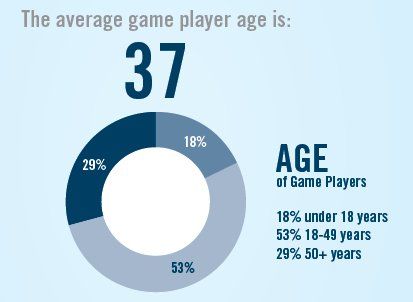This week the Entertainment Software Association (ESA) released a series of reports that they conducted about the current state of the videogame industry. While it took me a little bit to go through it, a few things stuck out to me, but they all revolve around how many misconceptions abound outside the industry itself today among consumers (the gamers in general), parents and politicians.
What is likely to be one of the biggest stories in the videogame industry this year – the ruling in favor of electronic media, such as videogames, in the Supreme Court a couple weeks ago – all came about, most likely, because of misconceptions. To compound that, these groups claiming that the Supreme Court reached the wrong decision seem to be spreading those misconceptions and acting on them, as well. So, let’s take the time to get a few things straight, shall we?
One of the biggest and most dire misconceptions is the amount and age of people playing videogames. This actually surprised me, as I figured the average age was much lower, but get a whiff of this: The average age for videogame players is 37 years old. I’m not even average yet, and won’t be for several more years. Who would have thunk? Here’s the breakdown.
- 18% of videogame players are under 18 years old
- 53% of videogame players are between 18 and 49 years old
- 29% of videogame players are 50+ years old
Aside from the startling revelation that the vast majority (82%) of people who play videogames are outside of the age range that most of these laws and general parental activist crapola is aimed at, notice that more people over 50 play videogames than under 18. That vastly cuts back the people, in general, that we need to worry about being underage and purchasing mature-rated games.
One of the other misconceptions – which actually tends to come up more within the industry and among gamers themselves – is that it is a male-dominated playing field. This is becoming less and less true as the years progress. Look at the numbers now:
- 58% of gamers are male
- 42% of gamers are female
That’s right, it is actually nearing a 50/50 split, which is awesome. It also says something to publishers and developers out there about how they market games.
On top of that, the disparity is even less when we talk about who mostly purchase videogames, that breakdown goes like this (and the gap closes most likely because of all the soccer moms buying little Jimmy his copy of Pokemon or the latest useless Nintendo peripheral for the Wii).
- 52% of game purchases are made by males
- 48% of game purchases are made by females
Back to the average age thing again, except this time we’ll do videogame purchases:
- 41 years old is the average age of a person purchasing a videogame
That kind of blows my mind, to be honest. Even though I’m well aware this industry hasn’t been dominated by the teen and pre-teen demographic for a decade or more, I certainly didn’t feel like the average age of purchasers, or, for that matter, gamers in general, was that high.
Now, here’s some more shockers for those out there who balk at the Supreme Court’s decision a couple years ago. I still maintain that it was likely a colossal waste of taxpayers’ money, regardless of which direction you lean. Here’s why – the rating system in place is doing an excellent job. Not just average, good, or even great, but excellent. Here’s some numbers.
- 91% of the time parents are present when games are purchased or rented
- 86% of the time children receive permission from their parents to purchase or rent a game
- 90% of parents pay attention to the content of the games their children play
- 98% of parents are confident in the accuracy of ESRB ratings
- 86% of parents are aware of the ESRB system
Notice – a whopping 98% of parents apparently believe that the ESRB ratings are an accurate indicator of what content a game holds. That’s a huge percentage. Yet, at the same time, they’re complaining that these ratings aren’t enough? I sense a disturbance in the force here.
What’s even more disturbing is that parents and others concerned about the Supreme Court’s ruling recently apparently overlooked the amount of their peers that use parental controls. In fact, videogames are the most controlled form of media by parents, for their children’s consumption.
- 80% of parents place time limits on or use parental controls on videogame usage
- 74% of parents place time limits on or use parental controls on Internet usage
- 70% of parents place time limits on or use parental controls on television usage
- 65% of parents place time limits on or use parental controls on movie viewing
Frankly, I’m downright surprised many on the opposing side of this Supreme Court ruling can still show their faces in public. Their concerns are admirable, no doubt, but the numbers just don’t back up those concerns in any way, shape or form.
The days of people outside and unfamiliar with the industry thinking that videogames are still something exclusively for kids is long past, and this misconception needs to die. Forever. The vast majority of gamers are legal adults 18 years of age and over, with 37 being the average age of those who play videogames. That is ridiculous.
Negativity aside, this shows you just how much the industry that many of us love has grown in the last 10-15 years. It did come from a time when the majority of gamers were teenagers, but that is no longer the case. Things have really grown from the proliferation of large blockbusters such as Call of Duty titles and World of Warcraft, to the crazy amount of casual mobile and platform-based titles that have sold since the introduction of the Wii and the iPhone. No longer do we live in an age where videogames should be considered toys for kids, but as a true entertainment medium just like movies and television.
You can check out the full report in the ESA’s “2011 Essential Facts About the Computer and Video Game Industry” [PDF], if you want a more in-depth look at things, care to peruse some quotes from those inside and outside the industry and want to look at more numbers. Let me tell you, there’s a whole lot more than what I listed here, I just briefly talked about the numbers that stood out to me.
As a gamer, how does all this make YOU feel?




